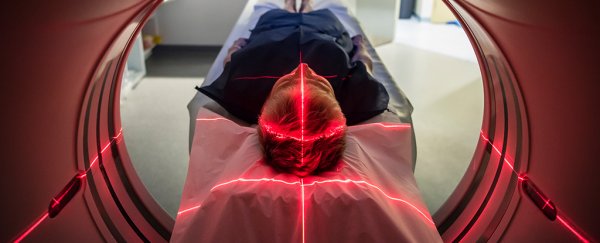Magnetic resonance imaging (MRI) is a non-destructive scanning technique that can measure density and chemical changes in various layers of material, like tissues or organs in the human body.
The scanner consists of two large and powerful magnets which produce a super-strong magnetic field, measured by scientists at tens of thousands of gauss. (For comparison's sake, a fridge magnet is rarely more than ten of these units).
When someone or something is put inside this magnetic field, it forces protons within a nucleus to line up. Pulses of radio waves are then sent through the material, causing these protons to jerk in and out of their magnetic orientation.
This 'jiggle' is picked up by banks of surrounding antennas as tiny changes in voltage, allowing different layers of material to be revealed.
One type of scanning, called 'functional' MRI, detects changes in blood flow in a specific area, particularly in the human brain. Another MRI technique, known as blood-oxygen-level-dependent imaging (BOLD) fMRI, looks for changes in oxygenated or deoxygenated blood.
Together, these different kinds of MRI have given us a whole new insight into the activity of neurons in the brain, revolutionising our attempts to map it and spinal cord in greater detail than ever before.
What are the pros and cons of MRIs?
Unlike imaging technology, which relies on dangerous ionising radiation – such as computed tomography (CT) and 2D X-ray photographs – MRI technology doesn't risk damaging DNA.
Today, there's no evidence that magnetic fields can cause harm, though some research suggests there is an extremely low chance of mildly adverse effects caused by magnetic fields pulling at magnetised ink particles in tattoos.
In a similar way, the scanner also poses a potential risk to those with metallic eyelashes or other forms of metal in their bodies, such as cochlear implants, pacemakers or aneurysm clips.
Unfortunately, an MRI also requires patients to lie still inside an enclosed space for a length of time, and some people can find the loud noises and tight space uncomfortable.
All in all, this non-invasive technique is one of the best and safest ways for physicians and researchers to diagnose and study diseases and other hidden ailments.
All topic-based articles are determined by fact checkers to be correct and relevant at the time of publishing. Text and images may be altered, removed, or added to as an editorial decision to keep information current.
